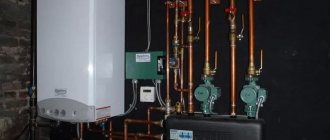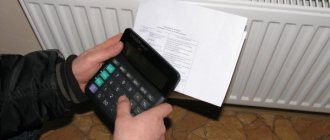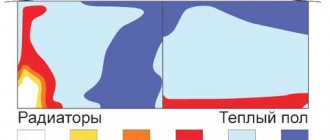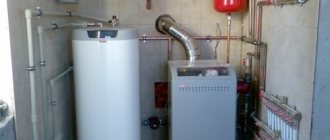Due to the climatic conditions of the region, heating apartments and houses in cold weather is a prerequisite for comfortable and safe living in them.
The beginning and end of the heating season are tied to a specific date, but adjustments can be made to the timing if the cold snap begins earlier than usual . Therefore, the heating season may have a different start date; this is decided by local authorities, city utility companies, and sanitary services.
For those apartment owners who use a centralized mains, it is important to know when heat will begin to be supplied. After all, violation of the regime is a reason to file a complaint with the responsible authority .
ATTENTION! The standard heating period is typical for houses with a centralized heat supply system. Homeowners with an individual boiler can independently turn the heating on or off.
Determination of the heating season
Traditionally, heat is provided to the apartment in the fall, somewhere in the middle of this time of year. This is when the air temperature begins to decrease. Inside the apartments, the air is cooled to the permissible limit. The duration of the heating period is about six months, its completion depends on the establishment of a comfortable outside temperature .
IMPORTANT! The appearance of the concept of a heating season in the public utilities sector became possible after the development of a centralized supply of thermal energy to apartment buildings.
Conclusion
Regardless of the duration of the cold season, equipment maintenance must be performed after its completion. In centralized systems, this procedure is regulated by authorities, while autonomous systems are maintained by their owners individually (see also the article “Do-it-yourself heating system: tips for a beginner”).
You can get some additional information on this topic from the video in this article.
Did you like the article? Subscribe to our Yandex.Zen channel
What law regulates the process of heating residential premises?
The dates that define the heating season - October 15 and April 15 - are arbitrary. Utilities are roughly guided by them when preparing equipment and networks for long-term operation during the cold period. But in reality, the start and finish of heating houses is set differently every year, depending on the weather and the average temperature outside.
On May 26, 2006, Decree of the Government of the Russian Federation No. 304 was issued, according to which, to start heating, the temperature must be fixed at no higher than 8 degrees for 5 days . To calculate the average temperature, the highest and lowest air readings for the day are summed up.
ATTENTION! Sometimes residents of houses complain that even after 5 days of cold (below 8 degrees), the radiators in the house are cold. But heat does not enter the apartments immediately after the boiler room is started; it may take more than one day to heat all objects evenly.
What to do
There is an algorithm of actions that must be followed in the event of dishonest work by utilities:
- Measure the room temperature in the apartment yourself. Compare the results obtained with the standards specified in GOSTs and SNPs.
- If a discrepancy is detected, you must contact the emergency service dispatcher. He will send a team of specialists to document the discrepancy.
- If emergency service specialists have not identified any deficiencies, submit a request to the management organization to determine the reasons for the temperature discrepancy. All requests must be completed in two copies, registered properly and kept for yourself one copy.
- Based on the results of the management organization’s activities, a report is also drawn up. One copy is also given to the applicant.
If temperature indicators do not meet the standards for residential premises, the management organization is obliged to correct the shortcomings during the working week and recalculate. If she did not do this, the residents have the right to appeal to higher authorities.
Principles of district heating
The pipeline through which heat is supplied to the house consists of pipes extending from the central city boiler house. Typically, the coolant in the pipeline is hot water. also be used for heating steam, electricity .
In apartments, pipes are installed at the hot water inlet and outlet. Thanks to a properly designed heating system, thermal energy is evenly distributed throughout the pipes and radiators. Centralized heating of apartments is used in settlements with different population sizes.
This type of heating is convenient, practical, and economical. But its duration does not always correspond to weather conditions. Therefore, it is important for apartment residents to know the norms for turning on the heating depending on the outside temperature.
Why is this necessary?
So, we have learned to calculate a certain parameter. And what to do with the taken value? The most obvious area of its application is estimating expected heating costs. But GSOP affects one more thing - the level of quality of building insulation.
The colder the winter, the greater the requirements SNiP 02/23/2003 'Thermal protection of buildings' places on this very protection.
To make the dependence more clear, it is worth mentioning one related concept - heat transfer resistance, which is standardized by the mentioned SNiP. It is measured in m2xC/W: the fewer watts of thermal energy transferred through a square meter of wall with a temperature difference of 1 degree on its sides, the better it resists heat leakage.
Here are some normalized heat transfer resistances for regions with different GSOP.
- For GSOP 2000 (Stavropol, Astrakhan region) the minimum thermal resistance of the walls is 2.1 m2*C/W.
- For GSOP 4000 (Volgograd and Belgorod regions) - 2.8.
- GSOP 6000 (Capital and Leningrad regions) - 3.5.
- GSOP 8000 (Magadan) - 4.2.
- GSOP 10000 (Chukotka) - 4.9.
- GSOP 12000 (Some areas of Yakutia, as well as the Verkhoyansk we mentioned) - 5.6.
Please note: SNiP standardizes the thermal resistance of not only walls, but also ceilings, as well as windows. The cost of deviation from the normalized values is a significant excess heat consumption.
What determines the start of heat supply?
At what room temperature the heating is turned on is a question that interests consumers every fall, because there is no desire to freeze in the house due to the fact that the autumn bad weather began earlier than expected. If a low average temperature remains in a residential area for a long time, this affects the health of the residents, the condition of the furnishings and the house itself .
ATTENTION! No matter what date the heating season starts, it is important that utility companies are fully prepared for it. It is necessary to check the integrity of the pipeline, the reliability of the boiler room equipment, and the readiness of the heating system inside the house to supply hot water.
- For some time, standards determined the start of heating in October throughout the country. But over such a large area, the climatic conditions in cities and villages are different and depend on the climate zone. And so the order of the start of the season was changed, as was its duration.
- Which months are included in the heating period? This also depends on the region. In hot areas, heating is needed only for a few months; the cold part of the country needs to heat houses almost the entire year (ten months).
By law, heat energy suppliers must turn on heating systems for residential buildings if the outside temperature is no higher than 8 degrees Celsius for more than 5 days.
But the rules and procedures for the heating season also take into account other important factors. Even if it is cold outside in early autumn or late spring, but weather forecasters predict rapid warming, the batteries may remain cold . During the inter-heating period, it is very rare to start the heating system; this is associated with high costs.
The official decree on the beginning of the centralized heating season for apartments and houses is a guide to action for municipal utilities in the locality. Before the release of such a resolution, experts calculate the most favorable beginning of the period; for this, they record data on the average daily outside air temperature several times a day, and study information from meteorologists and weather forecasters.
Read also: The most comfortable air temperature for humans.
ATTENTION! The heating period must begin before frost, since at an average temperature below zero, which persists for some time, the non-working equipment of the heating pipeline and boiler room fails. Expensive repairs will entail large expenses.
For the same reason, suppliers do not turn off the heat until the desired temperature outside has been established.
Preparing actions based on inspection results
After the spring inspection, it is necessary to draw up organizational measures, which will take into account the starting and ending numbers, when all the deficiencies found will be specifically eliminated:
it is mandatory to ensure high-quality drainage of natural waters on the territory of the house, blind areas, and basement; all structural elements necessary for work in the basement premises must be checked for serviceability; all joints and interfaces must be completely isolated from water, they must be free of any cracks, moisture stains, peeling of the protective layer of concrete structures and other problems; during an external inspection, it is necessary to ensure the proper condition of the walls, which should not have any cracks, collapsed plaster or insulation; when inspecting windows or doors, you need to take into account the serviceability of the frames, external glazing and the full volume of glazing; roofs must be provided with the required temperature and moisture conditions; ventilation systems must be checked to ensure they are fully capable of removing waste from gas stoves and water heaters; monitoring and complete control of the state of thermal insulation of heating systems inside houses.
Features of the end of the central heating season
- How long the heating period lasts and when it ends - it is important to know this information in order to demand high-quality utility services from heat suppliers. The months when you have to pay for heat are the most difficult in terms of financial costs for the population.
- It is impossible to say in advance in which month the heating will be turned off this year; it depends on weather conditions, the duration of low temperatures, and the climate zone in which the settlement is located. Therefore, modern law does not establish an exact date when the period of heating residential premises by a centralized system ends.
- Like the beginning of the heat supply, its end is related to the outside temperature. An important indicator for shutting off the coolant supply is maintaining a certain outside temperature for 5 days.
- Suppliers must strictly comply with this and other conditions for the end of the heating period.
If frost and low temperatures persist for a long time in the spring, the heating season will be delayed , although this will lead to high utility bills.
And yet, without a comfortable temperature in the house, it is impossible to live in it, relax, or maintain good health.
Duration of maintenance and repair of individual systems
After the degree-day of the heating period has reached a value when it is time to stop operating the heat supply system, a number of measures should be taken to preserve the equipment for the summer period. List of necessary actions:
- a thorough inspection of all elements of the heating system, including the boiler, radiators, pipelines, pumps, etc. for leaks and damage;
- if malfunctions are detected, they must be eliminated by first draining the coolant from the system;
- checking the functionality of automatic adjustment and control systems of a gas or electric boiler, pumps and other systems;
- replacement or repair of faulty components and mechanisms;
- After completion of maintenance and repair work, the system should be filled with coolant. Air pockets are removed using shut-off valves installed in certain places in the structure.
Carrying out a set of measures allows you to qualitatively prepare the heating system for the new cold season.
Is it possible to turn off during the heating season?
Suppliers must carefully prepare for each heating season, checking the condition of pipelines, boiler room equipment, and upgrading networks.
Nevertheless, even with a high quality of preparation , cases are not excluded when utility companies turn off the heating in houses or apartments . This is usually associated with emergency situations on pipeline lines or in the boiler room itself.
Also, heating of the house may be stopped temporarily due to damage to the pipeline in the premises of the residential building.
ATTENTION! According to the law, a shutdown during the heating period is impossible, but if it occurs, the time without heat supply should be minimal. Otherwise, the supplier will face fines and sanctions due to an irresponsible attitude to its responsibilities.
- If the room temperature is only 8 degrees Celsius, heating can only be stopped for 2 hours. At a temperature of 10 degrees - no more than 8 hours.
- It is only permissible to turn off the heat for 16 hours when the room temperature is 12 degrees.
- Even due to accidents during the heating period, the permissible number of hours without the supply of thermal energy is 24.
If utilities do not comply with these important rules established by law, consumers have the right to demand a recalculation of heating payments. Payment will be reduced by 0.5% for each hour of exceeding permissible standards.
Thermal calculation with example
A long time ago, buildings and structures were built without thinking about what thermal conductivity qualities the enclosing structures had. In other words, the walls were simply made thick. And if you have ever happened to be in old merchant houses, then you might have noticed that the outer walls of these houses are made of ceramic bricks, the thickness of which is about 1.5 meters. Such a thickness of the brick wall ensured and still ensures a completely comfortable stay for people in these houses, even in the most severe frosts.
Nowadays everything has changed. And now it is not economically profitable to make the walls so thick. Therefore, materials have been invented that can reduce it. Some of them are: insulation and gas silicate blocks. Thanks to these materials, for example, the thickness of brickwork can be reduced to 250 mm.
Now walls and ceilings are most often made of 2 or 3 layers, one layer of which is a material with good thermal insulation properties. And in order to determine the optimal thickness of this material, a thermal engineering calculation is carried out and the dew point is determined.
You can find out how to calculate the dew point on the next page. Thermal engineering calculations will also be considered here using an example.
The contested provision does not violate the citizen’s rights to health protection
The Supreme Court of the Russian Federation indicated that clause 5 of Rules No. 354 does not violate the plaintiff’s rights to health protection. On the contrary, compliance with this provision ensures that the residential premises are suitable for habitation.
The court also rejected the argument about the inconsistency of the disputed clause with the physiological needs of a person in ambient temperature, citing the fact that in cases of challenging legal acts, it checks such an act for its compliance with other normative legal acts that have greater legal force.











